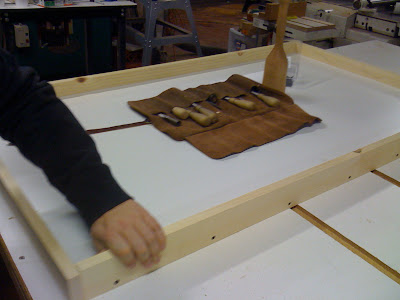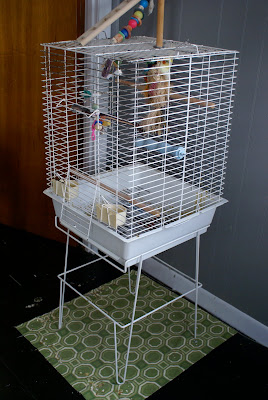As we recently moved into our new apartment, Dan and I considered the floors. (Ok, I freaked out over the really old wooden floor with giant gaps between some of the planks. Images of fat mice waiting in the shadows beneath the floorboards for bird crumbs plagued my thoughts.)
We knew we wanted to make a bird room out of one of the two upstairs bedrooms. Since the neighbor with sensitive ears "suggested" though the wall that we move the birds to the other room, they have made their home in the slightly larger, carpeted room on the other side of the apartment.
Carpet + bird poop = big mess
Dan and I bought melamine-coated sheets of MDF and plywood, and 1"x2" strips of pine. The coating on the plywood is durable and water-proof, and kind of has the feel of formica counter top material. We constructed giant floor protectors beneath each grouping of cages. The pine was attached to the sides and acts as a lip to help contain all of the seeds, crumbs, and feathers. I plan on using silicon caulk to seal the inside edges, but haven't gotten around to this yet.
It's already been helpful with weekly bird cleanup! I can easily scrub away stray poop, and splashed water is contained within the area. It's much easier in my opinion to sweep away debris below the cages instead of getting out the vacuum several times a week.
More pictures within the new bird room will follow...
Monday, May 17, 2010
Friday, April 16, 2010
Bird Owner in NYTimes Home Design
Check out Mr. Hunt Slonem’s interesting studio in NYC:
His studio is the antithesis of my current living situation, i.e., he has a 15,000 square foot apartment. If you look at the brief slide show, you'll see that he has brilliant colors, collections of endlessly repeating art, and PET BIRDS! It makes me happy to see his Amazon parrots make it into one of the shots.
Remember, kids: parrots are not decor. They don't care if their feathers match your paint and upholstery. Take good care of your feathered friends, Mr. Slonem!
His studio is the antithesis of my current living situation, i.e., he has a 15,000 square foot apartment. If you look at the brief slide show, you'll see that he has brilliant colors, collections of endlessly repeating art, and PET BIRDS! It makes me happy to see his Amazon parrots make it into one of the shots.
Remember, kids: parrots are not decor. They don't care if their feathers match your paint and upholstery. Take good care of your feathered friends, Mr. Slonem!
Monday, March 29, 2010
Poop on the floor, Part 1
You have a pet bird. You have poop on the floor, not to mention seeds, crumbs, pieces of veggies, and feathers.
There are metal skirts around Lenny & Twinkie's cages, but they like to sit on the very edges of them and stick their tail feathers right over the side.
What to do??
I bought some funky fabric and roughly hemmed giant pieces to go under target areas. Now, I can protect the floors, and I can wash the fabric instead of throwing away tons of newspaper each week. I made several poop-catchers so that I can swap them out while some are in the wash.
Check them out!
There are metal skirts around Lenny & Twinkie's cages, but they like to sit on the very edges of them and stick their tail feathers right over the side.
What to do??
I bought some funky fabric and roughly hemmed giant pieces to go under target areas. Now, I can protect the floors, and I can wash the fabric instead of throwing away tons of newspaper each week. I made several poop-catchers so that I can swap them out while some are in the wash.
Check them out!
Friday, January 8, 2010
What is missing from your air? Humidity!
Last winter, I took my two big birds for a yearly check-up. My Sun Conure had been sneezing, though he didn't seem ill otherwise. The doctor's prescription: humidity. Being from Louisiana, I never in a million years pictured myself buying and using a humidifier!
We quickly instituted winter use of the brand new humidifier. I run it in one location until the reservoir has emptied, then I move it to the next bird area. The cycle keeps going until I have rotated the humidifier through all of the rooms/bird areas. The whole process takes 3 days; like I said, we have a small apartment!
I've made other minor adjustments that seem to help the humidity levels throughout the apartment: not turning on the bathroom vent during a shower, then opening the door to let the steam flow out; cooking lots of soups and pasta; letting my tea kettle slowly steam away after I've poured my tea. The dry birdy sneezing has decreased dramatically. In case you're wondering why humidity is recommended for households with parrots:
"The moisture of the rainforest from rainfall, constant cloud cover, and transpiration (water loss through leaves), creates intense local humidity. Each canopy tree transpires some 200 gallons (760 liters) of water annually, translating to roughly 20,000 gallons (76,000 L) of water transpired into the atmosphere for every acre of canopy trees."
On the other hand, wild Cockatiels' range includes central Australia, where average annual humidity is only 30%.
Clearly, bird owners should research the origin and natural history of their pet birds. This information can help you decide how much humidity you should add to your bird's indoor environment. While our pets have been living with humans since hatching, their bodies are still adapted to their species' habitat elsewhere in the world.
*Photo by mcuscire on Flickr
We quickly instituted winter use of the brand new humidifier. I run it in one location until the reservoir has emptied, then I move it to the next bird area. The cycle keeps going until I have rotated the humidifier through all of the rooms/bird areas. The whole process takes 3 days; like I said, we have a small apartment!
I've made other minor adjustments that seem to help the humidity levels throughout the apartment: not turning on the bathroom vent during a shower, then opening the door to let the steam flow out; cooking lots of soups and pasta; letting my tea kettle slowly steam away after I've poured my tea. The dry birdy sneezing has decreased dramatically. In case you're wondering why humidity is recommended for households with parrots:
"The moisture of the rainforest from rainfall, constant cloud cover, and transpiration (water loss through leaves), creates intense local humidity. Each canopy tree transpires some 200 gallons (760 liters) of water annually, translating to roughly 20,000 gallons (76,000 L) of water transpired into the atmosphere for every acre of canopy trees."
On the other hand, wild Cockatiels' range includes central Australia, where average annual humidity is only 30%.
Clearly, bird owners should research the origin and natural history of their pet birds. This information can help you decide how much humidity you should add to your bird's indoor environment. While our pets have been living with humans since hatching, their bodies are still adapted to their species' habitat elsewhere in the world.
*Photo by mcuscire on Flickr
Saturday, January 2, 2010
Cold Toes - Keeping warm through winter
Winter, with plunging temperatures and dry air, can be tough on our feathery friends, who are better adapted to life in warm and tropical habitats. Throw in a nasty case of feather plucking, and you need to make serious adjustments to keep your birds healthy until spring. Over the course of my next few posts, I'll discuss common winter headaches and a few possible solutions.
Warm toes = warm bird. I recently moved my flock of five parrots and two canaries from Louisiana (very mild winters) to Rhode Island (snow!!). My first action was to buy a Thermo Perch from Drs. Foster and Smith for my slightly bald Sun Conure, Twinkie.
This perch plugs into an electrical oulet and maintains a constant temp of 102F (~39C). The cord is wrapped in a small-gauge steel coil to protect prying beaks. While the perch worked well for the duration of the season, Twinkie managed to pry his beak around the edge if the coil and sever the electrical cord. Thankfully, we had unplugged the perch, but not yet removed it from his cage when this happened. I maintain that this perch is a good investment, but it requires constant supervision when your feathery friend is out of his or her cage. The thermo perch might be relegated to a separate "sleeping cage" if you have this kind of set-up.
Does anyone have any other solutions for keeping bird toes warm? Is anyone having success keeping a feather plucker cozy?
(Photo from Drs. Foster and Smith website.)
Warm toes = warm bird. I recently moved my flock of five parrots and two canaries from Louisiana (very mild winters) to Rhode Island (snow!!). My first action was to buy a Thermo Perch from Drs. Foster and Smith for my slightly bald Sun Conure, Twinkie.
Does anyone have any other solutions for keeping bird toes warm? Is anyone having success keeping a feather plucker cozy?
(Photo from Drs. Foster and Smith website.)
Subscribe to:
Comments (Atom)










